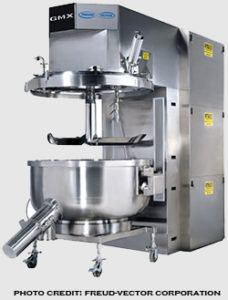A high-shear granulator consists of a cylindrical or conical mixing bowl, a three-bladed impeller, a chopper, an auxiliary chopper, a motor to drive the blades and a discharge pot. By either circulating hot or cool liquid or steam through the jacket, the mixing bowl is jacketed for heating or cooling the contents of the bowl as the case may be.
The high-shear wet granulation process using high-shear granulator can be divided into 5 stages and they included;
The impeller which is employed in mixing of the dry powder and spreading of the granulating fluid in high-shear granulator normally rotates at a speed ranging from 100 rpm to 500 rpm. The chopper forms part of high-shear granulator and is used to break down the wet lump to produce granules.
The chopper rotates at a speed of 1000 to 3000 rpm. Powder densification and/or agglomeration are by the in cooperation of a granulation fluid into the powder with high-power-per-unit mass, through rotating high-shear forces.
High-shear granulators can be sub-classified into vertical high-shear granulator and horizontal high-shear granulator. These sub-classes are primarily distinguished by the geometric positioning and orientation of the primary impellers.
A vertical high-shear granulator is where the impeller shaft rotates in the vertical plane and the impellers are bladelike. The vertical high-shear granulator could be either a top-driven (example Colleter-Gral granulator) or a bottom-driven unit (example Diosna or Powrex granulators).
In the horizontal high-shear granulator, the impeller shaft rotates in the horizontal plane (or is said to be side driven).
Read Also: Fluidized Bed Granulator
Contents

1. Granulation process requires less binder solution.
2. Granulation is achieved within a short time.
3. Greater densification and production of less friable granules.
4. The granulator produces reproducible less friable granules with a uniform particle size distribution.
5. High-shear granulator minimizes the exposure of drug dust to workers due to reduced process dust generation.
6. Granulation endpoint is predictable while using a high-shear granulator.
7. Requires short drying times.
1. High-shear granulators produce less compressible granules when compared to low-shear granulator.
2. It has a narrow range of operating conditions.
3. Over-wetting of the granules may lead to formation of large-sized lumps.
4. Thermolabile materials could be chemically degraded due to increase in temperature.
5. Mechanical degradation can take place in case of fragile particles.